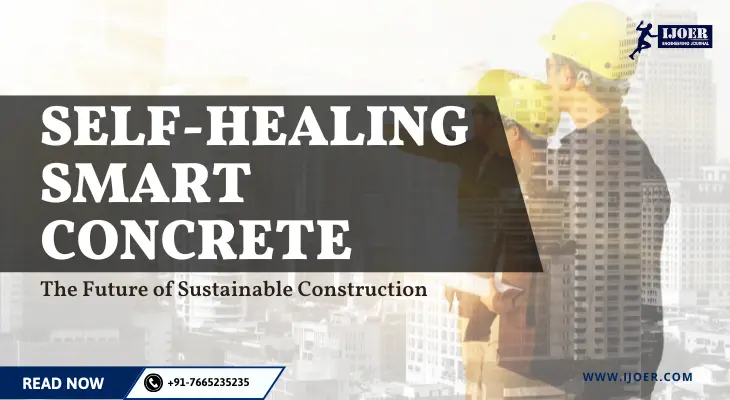
Concrete is the most widely used construction material in the world. From skyscrapers to bridges and highways, it forms the backbone of modern infrastructure. However, one of its biggest limitations is its tendency to develop cracks over time due to stress, temperature changes, and environmental exposure. These cracks not only reduce durability but also increase maintenance costs and safety risks.
Self-healing smart concrete is an innovative material designed to repair its own cracks without human intervention. This breakthrough is reshaping the construction industry, offering longer-lasting and more sustainable infrastructure solutions.
Self-healing concrete is an advanced type of concrete embedded with healing agents such as bacteria, capsules, or special polymers. When cracks form, these agents are activated, often by water or air exposure, filling and sealing the cracks naturally. This reduces the need for costly repairs and increases the service life of structures.
The concept of self-healing concrete is inspired by nature, where living organisms have the ability to repair themselves after injury. In civil engineering, researchers have applied this principle to concrete, creating innovative mechanisms that allow cracks to be repaired automatically. Several methods have been developed to achieve self-healing, each with unique processes and benefits:
One of the most revolutionary methods of self-healing concrete involves the use of bacteria.
Another promising method uses tiny capsules filled with healing agents embedded directly into the concrete.
Shape-memory technology involves incorporating fibers or polymers with "memory" properties into the concrete.
Concrete itself has a natural but limited self-healing ability called autogenous healing. This is enhanced in smart concrete designs.
| Method | Mechanism | Effective Crack Width | Applications |
|---|---|---|---|
| Bacteria-Based Healing | Bacteria (e.g., Bacillus subtilis) activated by water produce limestone to seal cracks. | Up to ~0.8 mm | Bridges, tunnels, marine structures, water-retaining structures. |
| Microcapsule Technology | Capsules with polymers/adhesives rupture when cracks form, releasing healing agents. | Up to ~0.5 mm | High-rise buildings, pavements, precast concrete elements. |
| Shape-Memory Materials | Polymers/fibers expand with heat/moisture to physically close cracks. | Up to ~1.0 mm | Earthquake-resistant buildings, dams, infrastructure in dynamic environments. |
| Autogenous Healing | Unreacted cement particles hydrate in presence of water, filling micro-cracks. | Up to ~0.2 mm | Conventional concrete structures, minor surface cracks in slabs and pavements |
While self-healing concrete shows immense promise, some challenges remain:
Ongoing research aims to address these issues and make self-healing concrete a mainstream construction material.
Self-healing smart concrete is not just a material; it is a revolution in civil engineering. With growing concerns over sustainability, climate change, and infrastructure resilience, this innovation could become the standard for future construction. Governments and private companies are already investing in pilot projects, signaling a future where roads, bridges, and buildings can repair themselves.
The introduction of self-healing smart concrete marks a turning point in construction technology. By combining biology, chemistry, and engineering, it provides a sustainable and cost-effective solution to one of the most persistent problems in infrastructure: cracks. While challenges remain, its benefits far outweigh the limitations, making it a cornerstone of future smart cities.
Q1. What is self-healing concrete?
Self-healing concrete is an advanced material designed to repair its own cracks automatically without human intervention. It uses methods such as bacteria, microcapsules, or shape-memory materials to seal cracks and restore strength.
Q2. Why is self-healing concrete important?
Traditional concrete structures often require costly repairs and maintenance due to cracking. Self-healing concrete reduces repair costs, extends lifespan, improves safety, and supports sustainable construction.
Q3. How does bacteria-based self-healing concrete work?
Bacteria and nutrients are added to the concrete mix. When cracks form and water enters, the bacteria become active and produce limestone, which fills and seals the cracks naturally.
Q4. Can self-healing concrete repair large cracks?
Currently, self-healing concrete is most effective for micro-cracks up to about 0.8 mm. For larger cracks, it can slow down damage progression but may still require manual repair.
Q5. Where is self-healing concrete used?
It is used in bridges, tunnels, dams, high-rise buildings, marine structures, and earthquake-resistant infrastructure where cracks pose serious safety and durability challenges.
Q6. Is self-healing concrete expensive?
Yes, it is more expensive upfront compared to traditional concrete. However, the reduced need for maintenance and repairs makes it cost-effective in the long run.
Q7. What are the main methods of self-healing in concrete?
The main methods include:
Q8. Is self-healing concrete eco-friendly?
Yes. By reducing the frequency of repairs and reconstruction, it lowers the carbon footprint and saves natural resources, making it a sustainable choice in construction.
Explore more resources on advanced construction technologies and materials research:

|
Citation Indices
|
All
|
Since 2020
|
Citation |
2359 |
1680 |
h-index |
19 |
15 |
i10-index |
57 |
24 |
|
Acceptance Rate (By Year)
|
|
|
Year
|
Percentage
|
|
2023
|
9.64%
|
|
2027
|
17.64%
|
|
2022
|
13.14%
|
|
2021
|
14.26%
|
|
2020
|
11.8%
|
|
2019
|
16.3%
|
|
2018
|
18.65%
|
|
2017
|
15.9%
|
|
2016
|
20.9%
|
|
2015
|
22.5%
|